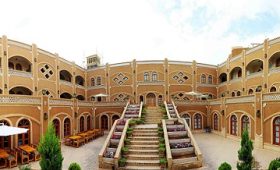Zarch Qanat: A UNESCO World Heritage Marvel of Yazd
The Zarch Qanat (also known as the Zarch Garden Qanat) is an ancient and extraordinary water system located in Yazd Province, Iran. Stretching over an impressive 71 kilometers with 2,115 wells, the Zarch Qanat is one of the longest and oldest qanats in the world, boasting a history that dates back more than 1,000 years. Recognized as a UNESCO World Heritage site, the Zarch Qanat is not only an engineering marvel but also a testament to the ingenuity and resourcefulness of ancient civilizations in desert regions.
A Brief History of the Zarch Qanat
The origins of the Zarch Qanat are believed to date back to the Sassanian period (224–651 CE), though some sources suggest that its construction might have begun even earlier, during the Parthian era. The qanat system was developed to provide a stable and sustainable source of water for the arid landscape of Yazd, a city that has long been known for its harsh desert climate. The place was designed to transport water from underground aquifers to the surface, making it crucial for agriculture, drinking, and daily life in the region.
Engineering Marvel and Construction
The place is a brilliant example of ancient hydraulic engineering. The qanat consists of a network of vertical wells, which are connected by gently sloping tunnels that tap into underground water sources. The water flows naturally from the wells to the surface, thanks to the gradual incline of the qanat, which allows for efficient and sustainable irrigation of the land. The Qanat’s 71-kilometer length and 2,115 wells make it a colossal feat of engineering, especially considering that it was constructed by hand using rudimentary tools.
One of the most remarkable features of the place is its depth. The qanat extends to depths of up to 50 meters in certain areas, with some wells reaching as deep as 80 meters. The depth and complexity of the qanat system reflect the immense knowledge and skills of the engineers and workers who built it.
Cultural and Historical Significance
The Zarch Qanat was essential to the survival and prosperity of Yazd, one of Iran’s oldest cities. The system provided the city with fresh water, even in the most arid conditions, and supported the growth of agriculture in the region. It also helped establish Yazd as an important center of trade and culture, as water was crucial for both sustaining local industries and attracting merchants from various parts of the ancient world.
Over the centuries, the Zarch Qanat has remained in continuous use, and many parts of it are still operational today. The qanat has been a lifeline for countless generations of people in the region, contributing to the development of local culture, traditions, and communities.
Zarch Qanat as a UNESCO World Heritage Site
In recognition of its historical, cultural, and engineering significance, the Zarch Qanat was designated a UNESCO World Heritage site as part of the Qanat System of Iran in 2016. This recognition highlights the qanat’s exceptional role in shaping the history of water management in arid regions and its ongoing importance as a sustainable water source in the modern era.
The inclusion of the Zarch Qanat in the UNESCO World Heritage list also underscores the need to preserve and protect this ancient system for future generations. As the world continues to face challenges related to water scarcity and climate change, the Zarch Qanat serves as a symbol of humanity’s ability to adapt to and thrive in harsh environments.
Visiting the Zarch Qanat
Today, the Zarch Qanat stands as both a functional water system and a popular tourist attraction. Visitors can explore various sections of the qanat, including the underground tunnels and wells, to witness firsthand the incredible craftsmanship and engineering that went into its construction. The qanat also offers a unique glimpse into the ancient culture and history of Yazd, and its significance is highlighted by its UNESCO World Heritage status.
The Zarch Qanat is a true testament to the resilience and ingenuity of ancient civilizations. As one of the oldest and longest qanats in the world, it continues to provide essential water to the people of Yazd while also serving as an enduring symbol of the ingenuity required to thrive in one of the world’s most challenging climates. Its designation as a UNESCO World Heritage site is a well-deserved recognition of its cultural, historical, and engineering importance, making it a must-visit destination for anyone interested in the wonders of ancient architecture and water management.




